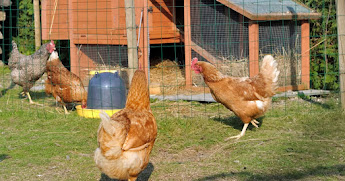Backyard
Poultry Farming
Pakistani poultry farming is as old as the country's civilization. Traditional poultry farming provided the majority of eggs and chicken meat nearly four decades ago. Typically, each family kept a few birds, which were mostly nurtured by women in addition to their other responsibilities. Birds were only given night shelter and were fed minimally' by kitchen garbage as and when it became available. They were then left to fend for themselves in gardens, village lanes, and nearby fields, eating on crop wastes, insects, worms, and greed forge. Barns and temporary homestead constructions are used to protect the bird from predators and bad weather, as well as to give a safe place to lay eggs.
Backyard poultry farming is an ancient technique in rural Pakistan that involves raising indigenous birds with low productivity. The meat and egg potential of indigenous birds are quite poor, making backyard poultry farming less economical. However, utilizing improved breeds in backyard chicken farming may easily be upgraded with better meat and egg production.
Advantages
of backyard poultry farming
The following are some of the ways that rearing
birds in a backyard system will aid the rural population.
Ø In
rural areas, backyard poultry farming is one of the most effective ways to
ensure the availability of poultry eggs and meat.
Ø It
helps you save money on eggs, poultry meat, and fertilizers for your garden.
Ø Poultry
eggs and meat, obtained by growing hens in the backyard, are the cheapest
source of animal protein for preventing malnutrition among the rural
population.
Ø Because
the production is practically organic, eggs and meat from the backyard have a
better taste and quality and may be sold for more money.
Ø It
employs the least amount of land labor and capital while providing a tiny but
consistent source of income.
Ø It
is a valuable resource for landless laborers and people without cattle, sheep,
or goats.
Ø It
does not necessitate a certain sort of housing, food, or management, therefore
it can be managed by uneducated people, females, and children.
Ø The
cycle begins with a tiny investment and continues with a small investment from
generation after generation.
Ø This
technique eliminates the cruelties of today's intensive poultry management
systems.
Ø Due to the triple benefits of self-employment, supplemental income, and the availability of a cheap supply of protein to combat malnutrition, poultry production is becoming recognized as a significant tool for socioeconomic betterment among the poorer sections of society.
Here are some points to keep in mind
The following points
must be under your consideration in backyard poultry farming.
1. Raise
high and standard breed of chicken.
2. Provide
the proper and balanced amount of diet according to the requirement of chicken.
3. Particular
attention should be paid to the proper choice of location and construction of the poultry shed.
4. Special
attention should be paid to vaccination and timely treatment.
5. Find
a suitable market for selling eggs or hens.
Building/Poultry
Shed
Laying hens require
2-2.5 square feet of living space. Care should be taken not to spend too much
money on its construction. The roof of the shed should be such that the sun
cannot enter and the birds are protected from the rain. The length of the
suitable shed should be east to west and the width should be north to south.
The floor of the shed should be solid so that it can be easily kept clean and
washed as needed. The height should be such that the shed can be cleaned
satisfactorily.
Utensils
for Hens
Feeders and waterers are
needed for better growth of hens. The use of these utensils keeps the shed
clean and significantly reduces food waste. Different kinds of utensils are
used according to the age of the birds.
1. Trough
feeder: These utensils are used for chicks from one day to 5 weeks of age.
2. Tube
feeder: These utensils are used for hens from 5 weeks to puberty.
3. Waterer:
The use of the waterer keeps the water clean. One waterer is enough for 25 birds.
Dimension
for Nest
Nest
contains 1.5'× 1'× 1.5' boxes. One nest is enough for 5 hens. Their use
protects the eggs from breaking and the eggs from getting dirty.
Chicks
Hatching
There are two ways to get chicks from eggs.
1. Natural
Method: Used in rural areas by using dry hens.
2. Artificial
Method: Used in commercial poultry farming by using a hatching machine.
The Season for Chicks Hatching
Chicks should be hatched in weather that
is neither too cold nor too hot so that the chicks can be protected from the
extreme weather and take good care of themselves.
Selection
of Eggs for Chicks Hatching
1. Eggs
should be neat and clean.
2. Eggs
should not contain any kind of dirt.
3. More chicks can be obtained from medium size eggs.
4. Eggs
shell should not be soft so that it can easily break after little pressure.
5. Eggs
should not be stored for more than one week.
Feed
Formulation for Laying Hens
According to the following formula, ten
kilograms of feed can be prepared at home for laying hens.
|
Serial No |
Ingredients |
Quantity |
|
1 |
Dry Bread |
6 kg |
|
2 |
Cotton seed cake |
1 kg |
|
3 |
Sunflower Meal |
1 kg |
|
4 |
Red Lentil, Green Lentil, Gram |
0.5 kg |
|
5 |
Wheat Bran |
0.5 kg |
|
6 |
Limestone |
250 grams |
|
7 |
Bone Meal |
250 grams |
|
8 |
Green Fodders |
0.5 kg |
Soak the above-mentioned ingredients in a sufficient amount of water for one hour. Then cook it for 15-20 minutes and mix
it properly. Add 30 grams of salt while mixing the ingredients. When the soft
paste is ready, take it off, cool it, put it in the feeders, and feed to hens.
This feed can meet the daily requirement of 100 hens.
Vaccination
|
Age |
Vaccine |
Dose/bird (ml) |
Route |
|
Just
after hatching |
Marek’s |
0.3
cc |
Sub-cut |
|
5-7
days |
ND+IB |
0.025
cc (one drop) |
E/D |
|
9
days |
HPS |
0.25
cc |
I/M |
|
8-12
days |
IBD |
0.025
cc (one drop) |
E/D |
|
18-20
days |
IBD |
- |
D/W |
|
21-22
days |
ND
(Lasota) |
- |
D/W |
|
28-30
days |
IBD |
- |
D/W |
|
32-34
days |
ND
(Lasota) |
- |
D/W |
|
6th
week |
Fowl
Pox |
One
dip of prong |
W/W |
|
8th
week |
Coryza |
0.25
cc |
S/C
OR I/M |
|
10th
week |
ND+IB |
- |
D/W |
|
14th
week |
Coryza |
0.25
cc |
S/C
OR I/M |
|
16th
week |
ND+IB+EDS |
0.25
cc |
S/C
OR I/M |
|
After
every two month |
ND
(Lasota) |
- |
D/W |
Note:
1. Re-vaccinate
tour birds against ND every two months.
2. Vaccines schedule may vary depending on the nature of the disease in different areas.
It is necessary to keep proper records on the date of vaccination and on vaccines used including type, brand, and serial number, date of purchase, and date of use of a vaccine.
Availability
of Medicine
You can get all the medicines for your birds from a veterinary
hospital by consulting a veterinarian in your country.
For more guidance and consultancy feel free to reach out to me. I'd be happy to assist you.







0 Comments